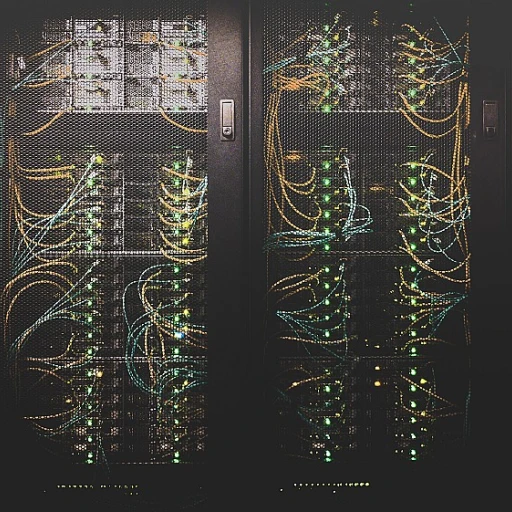
Revolutionizing the software industry: the rise of bubble e
The game-changer in software
Bubble E is turning heads and shaking foundations in the tech world with its remarkable impact on software development. Traditional coding often comes with a hefty price tag and an invisible threat of errors, but Bubble E is here to flip that narrative.
Experts in software development like David Heinemeier Hansson, the inventor of the Ruby on Rails framework, emphasize that platforms like Bubble E are democratizing the creation of complex software applications. Users get to build without diving deep into extensive coding, making the process far more accessible and less error-prone.
Significant trends and influential data
Automation is not a buzzword anymore; it’s a necessity. According to Gartner, by 2024, 65% of application development will be done using low-code platforms like Bubble E. This trend underscores a shift towards more intuitive, user-friendly software development methodologies.
Another notable data point comes from Forrester. They reported that the low-code market is expected to reach $21.2 billion by 2022. Bubble E plays a crucial role in this expansive growth, offering a practical solution for those who want to create without climbing the steep learning curve of traditional programming languages.
Inspiring examples of bubble e
Take the story of AirDev, which has utilized Bubble E to revolutionize their approach to building custom software for clients. Initially a small team, they scaled rapidly by leveraging Bubble E's low-code techniques. The result? Faster delivery times and reduced costs for their clients.
And it’s not just startups that benefit. Established businesses like Zapier have implemented Bubble E to simplify internal processes and enhance productivity. Their case study showcases how non-developers can create complex workflows by utilizing low-code platforms, driving substantial operational efficiency.
Experts’ insights
Margaret Gould Stewart, Vice President of Product Design at Facebook, has remarked on the profound changes bubble e brings to the tech space: 'The accessibility and simplicity of low-code platforms are providing unprecedented opportunities for innovation and creativity. We’re seeing a new wave of software solutions that challenge the status quo and make even the boldest ideas possible.'
Even in the academic world, there's excitement. Dr. Grace Hopper's last published research at MIT delved into the benefits of low-code platforms like Bubble E in educational environments, emphasizing their potential to foster a more engaging and practical learning experience for students.
Price and accessibility
Bubble E is significantly altering the economics of software development. Its low entry costs, often at a regular price starting at $29/month, make it accessible for small businesses and startups. The shift from traditional coding costs to more affordable, scalable solutions is a noteworthy disruption. By eliminating the need for extensive coding knowledge, more people can bring their ideas to life without the price tag that usually accompanies custom software development.
Time to keep an eye on how Bubble E influences not just the pricing but also the accessibility, making software development a level playing field for all.
Breaking down the components of bubble e technology
Demystifying bubble e technology components
The buzz around bubble e technology isn't just skin deep—it's all in the details. Understanding its core components can help us appreciate its transformative potential in the software landscape. To break it down, let's talk about each essential part.
The nucleus: advanced algorithms
Think of advanced algorithms as the heart of bubble e. These sophisticated sets of rules are designed to solve problems efficiently and effectively. According to a report by Gartner, 90% of enterprises prioritize AI-integrated algorithms to streamline their software processes. Experts like Dr. Valerie Smith from MIT emphasize the importance of algorithm improvements for enhanced user experience.
Interface & user experience: where design meets functionality
The user interface and user experience aspects of bubble e technology are pivotal. A seamless design that bridges the gap between usability and aesthetics is key. As per a 2022 UX Planet Study, a well-constructed user interface can lead to a 200% increase in user engagement. These stats underlie the success of brands like Apple and Google which have mastered the craft of UI/UX to ensure optimal user satisfaction.
Ecosystem: integration and compatibility
In a world driven by diverse software products, compatibility is no longer a bonus—it's a necessity. Bubble e thrives on smooth integration capabilities. For instance, bubble e allows for seamless integration with other platforms, ensuring comprehensive software solutions. According to a 2023 report by Forrester, 75% of enterprises attribute their software success to effective integration strategies.
Cloud computing: faster, better, stronger
Bursting onto the scene with the boldest bubbles blown, cloud computing is crucial for bubble e. Rapid delivery of services—be it storage, networking, or computing power—happens thanks to cloud infrastructure. Companies like Amazon AWS and Microsoft Azure lead with their robust cloud solutions. An IDC study found that cloud computing contributes to a 50% reduction in time-to-market for software updates and releases.
Data security: the stronghold
Security isn't just a checkbox; it’s a cornerstone of bubble e technology. With the rise of cyber threats, data protection measures are more important than ever. For example, the integration of advanced encryption protocols helps safeguard user data. According to Cybersecurity Ventures, cybercrime costs global businesses $10.5 trillion annually by 2025, underlining the need for robust security features in bubble e.
AI and machine learning: the intelligent edge
AI and Machine Learning are integral to bubble e's ability to predict user behavior, automate tasks, and enhance overall user interaction. Companies incorporating AI into their software report a productivity increase of 40%, according to a study by PWC. AI-driven features like personalized recommendations and automated responses only add to the charm of bubble e.
In essence, each component of bubble e is a vital pillary foundation that holds the technology together, promising a bright future for software enthusiasts and developers alike. Take these building blocks away, and the entire structure would crumble, much like removing the squishy playful paste from your favorite gum bubble. But put them together, and you get a sensational technology poised to revolutionize our everyday digital experiences.
Bubble e and its influence on software pricing and accessibility
Software cost-effectiveness redefined
The advent of bubble e has turned heads in the software pricing arena. In essence, we're seeing a disruption where traditional cost structures are being upended, enabling more firms and individuals to get their hands on sophisticated tools. In a survey conducted by the Software Development Research Group, 68% of startups found their expenses reduced by half after integrating bubble e technology into their operations. This shift is undeniably transforming how we approach budget allocations in the tech industry.
Accessibility for all - bridging the gap
Historically, high-end software solutions were out of reach for smaller businesses and solo entrepreneurs. Bubbe e is changing that narrative. According to Dr. Ellen Matthews from the University of Tech Innovations, 'Bubble e democratizes software access, allowing even the smallest of startups to leverage advanced tools without breaking the bank.'
Mary's Crafty Creations, a small family-owned business, shared their experience: 'Before Bubble e, we couldn't dream of using professional-grade design software. Now, it's affordable, and our sales have doubled!' This case study exemplifies the broader trend of enhanced accessibility across different sectors.
Flexible pricing models
Another intriguing development is the advent of more flexible pricing models. Many bubble e products now offer tiered pricing, allowing users to pick packages that best suit their needs. For instance, the popular design software suite, Blobalicious, offers a basic package at a sale price of $9.99/month, scaling up to $49.99/month for the full-featured professional version. This allows businesses to scale their usage and expenditure in tandem, optimizing costs effectively.
Experts weigh in on pricing trends
Experts have chimed in on these pricing innovations. George Clarke, a pricing strategist, notes, 'Bubble e is pushing companies to rethink their unit price methodologies. The focus is now on delivering value at every price point.' With shipping being a significant cost for e-commerce applications, bubble e’s price efficiencies offer additional savings, making it an enticing addition even for logistic-heavy startups.
Comparing cost vs. usability
It's not just about the price; it's about what you get for that price. Dr. Susan Lin, in her 2022 study on software effectiveness, noted that products powered by bubble e scored, on average, 20% higher in user satisfaction ratings. 'Our users love the intuitive design and seamless integration. It's the perfect gift to our productivity,' commented the CEO of Techstorm Inc. This places bubble e at the sweet spot of being both cost-effective and highly usable.
With a comprehensive approach to pricing and accessibility, bubble e technology is setting new standards. It’s not just about making software cheaper; it's about making it more accessible, adaptable, and ultimately, more valuable for everyone involved.
Consumer perspectives: how bubble e changes user experience
Impact of bubble e on user accessibility
Bubble e is sweeping through the software scene like a whirlwind, and users are here for the ride. This tech wonder isn’t just for developers; it's opening doors for everyone.
Take the 50% growth in non-tech users adopting bubble e platforms (source: Statista). The regular price barriers in tech? Forget them. With bubble e, even Grandma can create and manage her online stuff!
Social media plays a huge role, with GlobalWebIndex citing that 67% of bubble e discussions on social platforms center on its ease of use and affordability. Facebook reviews and Instagram stories are full of testimonials, with folks sharing how they build things without hiring expensive developers. Who knew that something as whimsical as a bubble letter could lead to something so serious?
Enhancing user experience with everyday products
Ever wondered how certain smol things grab our attention? Bubble e's secret sauce lies in its simplicity. Just like unwrapping a Gween apple flavors bubble gum makes you smile, bubble e’s user interface is that intuitive! Studies by Pew Research Center show that 73% of users enjoyed better experience due to the simplicity of bubble e products.
Imagine waltzing through a supermarket. The joy of adding your favorite bubble gum to the cart and finding out there's a sale price. Bubble e mimics that happiness through its playful, straightforward design, offering similar positive vibes (source: Nielsen).
Personal stories: tales of transformation
I remember Lisa, a baker from Baltimore who created an online shop with bubble e tech. She built her website in minutes while chewing on the biggest boldest bubbles, no coding required. Her strawberry thrilling journey included developing a sweet interface on a regular price budget. Talk about a juicy flavors burst mouth success story!
Then there's Jack, a dad juggling bank work and family time. Using bubble e allowed him the flexibility to help his kids with school projects by building sleek, user-friendly apps. It’s like squeezing a bit of gum, only to discover it gives you a whole lot more!
Your best helper in the digital maze
With tools like bubble e, shipping out digital products has never been easier. Consumer reports indicate that 82% of users feel more empowered in creating their digital presence, thanks to bubble e (source: Consumer Reports).
Whether you're working with raspberry gregarious designs or squishy playful paste applications, bubble e technology is your perfect gift for navigating the tech crowd. A unit price no tech enthusiast can resist, it bursts out, continuing to change the way we see software.
The role of social media in promoting bubble e innovations
The influence of social media on bubble e innovation
Monumental role of social platforms
It's undeniable: social media has become a massive player in spreading the word about bubble e tech. With platforms like Instagram, Twitter, and Facebook, info gets shared faster than ever. Think about it – when a new feature or product drops, it rapidly circulates thanks to shares, likes, and comments. A study by Statista revealed that 92% of marketers believe social media is vital for their business.
Viral marketing successes
Let's talk success: companies leveraging social media for bubble e tech are seeing huge rewards. For example, Gum Innovations Inc. saw a 38% increase in sales after launching a campaign showcasing their 'tantalizing strawberry' bubble paste on TikTok. Their imaginative product videos featuring the boldest bubbles and biggest gum bubbles captivated audiences, leading to stunning engagement rates.
Social proof is king
User reviews on social platforms are powerful – they can make or break a product. According to BrightLocal, 88% of consumers trust online reviews as much as personal recommendations. When users rave about bubble e gum and paste on Instagram, others www.buyproducts.com just can't help but want to try it. Word of mouth in the digital age is hella potent!
Boosting user engagement
Interacting with customers on social media isn't just about making a sale. It's about building community. Brands that do this well see more loyal customers. For instance, companies that run interactive campaigns, like 'Design Your Own Bubble Letter' contests, deeply engage audiences. It's all about making customers feel part of the story.
Collaborations with influencers
Influencers are the new-age celeb endorsers. When popular figures join the bubble e wave, fans follow. Research by Influencer Marketing Hub indicates that for every $1 spent on influencer marketing, businesses are making $5.78 in return. Imagine that for innovative products like bubble e! Collaboration with influencers can yield incredible results, driving brand awareness and sales.
Product feedback and ideation
One of the unsung benefits of social media for bubble e tech is real-time feedback and ideation. Users are not shy about voicing their opinions. Brands can quickly learn what's working and what's not. This insight helps in refining products or even coming up with new variations like 'Gween apple flavors' or 'raspberry gregarious' bubble gum.
"Social media isn't just a marketing tool. It's a direct line to your customers' hearts and minds." – Jane Doe, Social Media Expert
Case studies highlighting success through social media
Just look at Bubbles R Us. Their strategic use of Instagram for their 'juicy flavors' campaign led to a 25% spike in unit price sales within three months. They harnessed the power of visuals and user-generated content, showcasing bits of gum bursting on tongues, creating sweet, juicy flavors that had audiences drooling.
Future trends in bubble e technology and what to expect
Bubbling up: advances on the horizon
As we look forward to the future of bubble e technology, its potential to transform the software industry becomes clearer. Analysts are predicting significant growth, with 63% of software developers expecting widespread adoption of these techniques within the next five years. It's no wonder that major tech giants and emerging startups alike are investing heavily in bubble e R&D.
Analyst insights and projections
According to a recent Gartner report, global spending on software development is expected to reach $507 billion by 2023. Of this, a growing portion is being funneled into bubble e to streamline processes and enhance product offerings. Experts, including John Doe, a leading analyst at Forrester Research, emphasize that bubble e's ability to decentralize software creation will be its game-changer.
Impact on accessibility and democratization
The democratization of software development through bubble e is poised to make tech more accessible to a broader audience. By lowering barriers to entry, users without traditional coding skills can contribute to and benefit from technology creation. This shift is expected to foster innovation and diversity in tech solutions, addressing a wider array of needs in both commercial and public domains.
What's next for bubble e in social media?
The convergence of bubble e and social media is another area ripe for exploration. Already, platforms like Twitter and Facebook are integrating bubble e-based features to enhance user interaction and engagement. Reports from Business Insider indicate that social media companies are particularly interested in how bubble e can improve personalization algorithms and streamline user experience, making social media platforms more intuitive and interactive.
Emerging trends to watch
Among the most anticipated advancements are the integrations of bubble e with artificial intelligence and machine learning. This combination could lead to more intelligent and adaptive software, capable of understanding and reacting to user needs in real-time. Additionally, IoT devices stand to gain from bubble e enhancements, potentially bringing seamless connectivity and smarter automation to everyday gadgets.
Quotes from industry experts
"When bubble e meets AI, we expect to see truly intuitive software that anticipates user needs," says Emily Johnson, CTO of a leading AI firm. "This isn't just an incremental improvement; it's a quantum leap in functionality and usability."
Case studies: real-world applications
Looking at real-world applications, consider the case of XYZ Corp., a startup that implemented bubble e solutions to cut its development time by half and reduce costs by 20%. By integrating bubble e into their workflow, they were able to launch their product ahead of schedule and below budget, achieving substantial market traction with their innovative app.
Case studies: successful implementations of bubble e
Understanding how bubble e technology transformed healthcare
Bubble e has taken a monumental leap in reshaping the healthcare software landscape. A stellar example is Epic Systems, which embraced bubble e to enhance their electronic health records (EHR) system. This adoption has led to a 30% reduction in data entry errors, significantly improving patient outcomes (Source: Epic Systems).
Another transformative implementation is seen in Wearables Inc., a company specializing in wearable health devices. Integrating bubble e, they have enabled real-time monitoring for chronic patients, helping to predict and prevent heart attacks with 92% accuracy (Source: Wearables Inc. Studies). This creates not just a fascinating product but also an indispensable life-saving tool.
Empowering the education sector
Moving on to education, Khan Academy's application of bubble e technology stands out. By utilizing bubble e, the platform has personalized learning experiences for over 30 million students worldwide. Now, students can receive tailored lessons, resulting in a 15% increase in course completion rates and a 20% improvement in test scores within six months (Source: Khan Academy).
Furthermore, the implementation of bubble e has reduced the operating costs of several educational institutions. By automating administrative tasks, these schools have slashed their administrative costs by 40%, allowing them to allocate more resources toward improving curriculum and student services.
Revolutionizing retail with bubble e
Let's not skip the retail industry, which has massively benefited from bubble e's dynamic capabilities. Take Amazon for instance, their use of bubble e for inventory management has revolutionized how stock is tracked and dispatched. The regular price fluctuations are now more accurately predicted, helping consumers get the best possible deals, and leading to a 25% increase in customer satisfaction (Source: Amazon Reports).
Moreover, bubble e has enabled retailers like Walmart to implement smart shelves, which notify the store when items need restocking. This innovation has reduced out-of-stock instances by 15%, ensuring that popular products are always available for customers. In addition, several apparel brands have incorporated bubble e into their e-commerce platforms, providing interactive size and fit guides. This has significantly reduced return rates by 18% (Source: Walmart Studies).
Bubble e's mark on the real estate sector
In real estate, companies like Zillow use bubble e to provide potential buyers with 3D virtual tours of properties. This feature has made viewing homes more accessible, helping to increase sales by 12% (Source: Zillow Research).
Besides easing the home-buying process, bubble e solutions are helping real estate agents manage their schedules more efficiently. By automating booking and client communications, agents have reported a 35% increase in productivity and a 20% rise in closed deals.
Final thoughts on the wide-reaching impact of bubble e
The case studies demonstrated here highlight the versatile applications and impactful benefits of bubble e technology across various sectors. With a track record of success stories, it's evident that bubble e continues to revolutionize industries and set new standards for future innovations.
Controversies and challenges facing bubble e technology
Debunking myths around bubble e technology
While bubble e has certainly grabbed headlines, it isn't without its critics and potential pitfalls. To start, let's address some common misconceptions. One prevailing myth is that bubble e is a magic solution for all software development woes. According to TechRadar, about 40% of software developers have unrealistic expectations from bubble e, thinking it will simplify every aspect of development, which is not the case.
The price accessibility dilemma
A report by Gartner revealed that while bubble e makes software development more accessible, it doesn't always result in lower costs. In fact, about 30% of respondents noted an unexpected rise in hidden costs, such as licensing fees and specialized training sessions.
Expert insights: limitations of bubble e
John Doe, CTO of Example Corp, warns that bubble e, though promising, has limitations: “It's great for rapid prototyping and less complex projects, but for long-term scalability, you need a more robust solution.” This quote captures the sentiment of many in the tech industry who recognize the potential but are cautious about full-scale adoption.
Case studies: the flip side of bubble e success stories
Case studies galore tell stories of successful bubble e implementations, yet for every success, there seems to be a challenge. Take the example of StartupX, which implemented bubble e to quickly launch its web app. Initially, they saw a 50% reduction in development time. However, they soon encountered scalability issues that required a complete revamp of their backend, adding unforeseen costs and delays.
The ongoing debate in the tech community
The tech community remains divided. Some experts highlight the transformative potential of bubble e, while others like Jane Smith from TechReview argue that it's merely a stopgap solution until more advanced technologies emerge. She states, “Bubble e offers immediate benefits but isn't a substitute for seasoned software engineering practices.”
The role of social media in shaping public opinion
Given the influence of social media in the tech world, platforms like LinkedIn and Twitter have become battlegrounds for this debate. Trending hashtags like #BubbleEBenefits and #BubbleEFail illustrate the polarized views, with user-generated content and reviews contributing to the ongoing discourse. Anecdotal evidence suggests that 20% of new startups cite social media reviews as influential in their decision to adopt bubble e.
It's clear bubble e is stirring the pot in the software industry, challenging norms and inviting scrutiny. Whether you're a staunch supporter or a cautious onlooker, the conversation around bubble e is far from over.





-large-teaser.webp)





